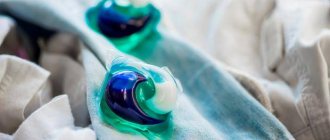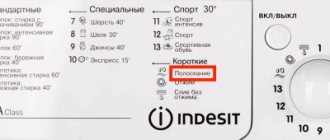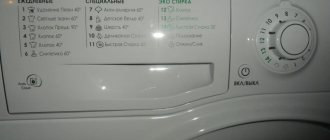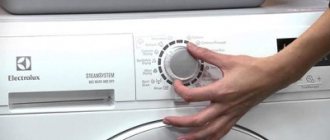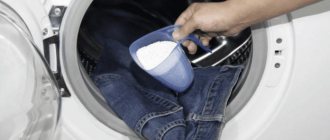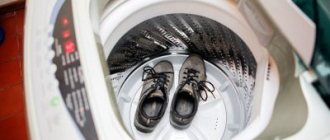The use of special rinsing agents has a positive effect on the condition of things. Powders and gels clean products from dirt, and fabric softeners used in automatic washing machines give them softness and a pleasant aroma.
- What is fabric softener
- Action of the product
- Softener composition
- What things is it suitable for?
- How to add when hand washing
- How to add to SMA
- Types of rinse aids
- conclusions
Why do you need fabric conditioner?
Housewives have very mixed opinions about fabric softeners. Some people think that the drugs are stuffed with harmful chemical components and do not use them. Others, on the contrary, like the pleasant aroma and quality of the material after washing using fabric softener.
As you know, the washing cycle in an automatic machine includes 4 stages: pre-wash (soaking), main wash, rinse, spin. To rinse, you can use a special rinse aid - conditioner. There is a special compartment in the machine for this purpose. The substance saturates the laundry with a pleasant aroma, makes the fabric softer and more pleasant to the touch.
Every third housewife notes that after using a fabric softener, things accumulate less static electricity and become dirty more slowly. The product is usually used for washing bed and underwear, towels, woolen and synthetic products.
Terms of use
Now that you know what fabric softener does, you need to learn how to use it correctly. The first rule is to use strictly the amount of product indicated in the instructions for use. A small dose will not give the desired effect, and excess conditioner will not rinse out and can cause an allergic reaction.
Washing softeners: pros and cons
To understand whether you really need a laundry conditioner, analyze the advantages and disadvantages of the products and study their composition before use.
Advantages and disadvantages
Advantages:
- laundry becomes softer and more fragrant;
- the electrostatic effect is reduced;
- ironing becomes easier;
- the color of the fabric does not fade;
- things get dirty less;
- Pills appear on clothes less often.
Flaws:
- It is not recommended to use for washing children's clothes;
- poorly tolerated by people suffering from allergies or respiratory diseases;
- The most low-budget products are stuffed with harmful chemicals that can cause dangerous diseases.
Conditioner composition
The substance that underlies all air conditioners on the household chemicals market is capable of creating a special protective layer on the material. It is represented by cationic compounds, which break down and settle on tissue fibers. As a result, the material becomes softer and gets less dirty.
Rinse aids may also include:
- chloroform;
- ethanol;
- camphor;
- terpineol;
- acetic acid ester;
- limonene;
- benzyl acetate;
- A-terpineol.
Some of the listed chemical compounds belong to the 2nd class of hazard and toxicity.
How to choose?
If you haven't made up your mind yet, think about why you need fabric softener. Our theses will help you figure it out faster.
- If you are categorically against any “chemicals”, it is not necessary to use a store-bought mouthwash. You can prepare the product yourself from natural ingredients at hand (you will learn how below).
- When buying an air conditioner in a store, carefully study the composition. Do not buy products with dangerous chemical compounds. It is better to give preference to rinses with active biological components that can break down into simple substances under the influence of external factors.
- Air conditioners are concentrated and non-concentrated. In the first option, the consumption of the product will be less, which means it will be used longer.
- Ease of use. When choosing, pay attention to the packaging. The presence of a dispenser cap or a watering can will be a pleasant bonus, since it will be easier to measure the required amount of product for one use.
By following simple selection rules, you can buy a really good product that will provide high-quality results.
What harm can it cause
Any chemical product has both benefits and harm. This does not apply to all air conditioners, but only to those that are stuffed with harmful compounds that are dangerous to the human body.
Linalool
Many fabric softeners are guilty of containing linoleum, which gives the laundry the smell of lily of the valley, jasmine, and sage. If you constantly use such a concentrate, you can get cancer. Contact with the substance leads to the formation of cancerous tumors in women. Most often it is cancer of the breast and uterus. For allergy sufferers, scented products are also dangerous.
Terpineol
Terpineol compounds as components of conditioner give linen the scents of rose, jasmine, and hyacinth. In humans, products containing isomeric monoterpene alcohols cause drowsiness and loss of energy. When inhaling terpineol vapors, irritation of the mucous membranes occurs and breathing difficulties develop. At high concentrations, pathologies of the central nervous system occur. In older people, Alzheimer's disease and dementia progress faster.
Benzyl alcohol
When this substance enters the respiratory system, it irritates the respiratory tract. The person begins to feel dizziness, nausea, vomiting, and low blood pressure.
Chloroform
If manufacturers include chloroform in the product, then its vapors are dangerous to humans. When heated, the product releases substances that can:
- lose consciousness;
- fall into a drowsy state;
- feel weak and dizzy.
In persons with kidney, liver, or heart failure, the symptoms of the disease will increase.
Ethanol
Ethanol is used to soften laundry fibers during washing. The substance is a hazardous waste eicosapentaenoic fatty acid, or EPA. It causes damage to the central nervous system and its disorders due to frequent contact with ethanol and its entry into the human body.
How to use conditioner when washing in a machine?
On the packaging of any fabric softener you will find instructions for use. It will be clearly stated here what to do, how to do it, and how much product to use. However, not all housewives know the little tricks of using fabric softeners.
Proper use of an air conditioner includes the following nuances:
- Maintaining the correct dosage. If you pour too much product, the laundry will not be rinsed; if you pour too little, the desired effect will not be achieved.
- Type of air conditioner. Manufacturers are updating their product lines and adding special rinses for synthetics, wool or children's items. Use the selected rinse aid only for its intended purpose in accordance with the type of fabric.
- Substance concentration. Be sure to dilute concentrated conditioners with water in a ratio of 1:3, otherwise the substance will not be easily washed out of the fabric.
After use, do not forget to rinse the detergent compartment, otherwise over time the tray will become clogged and cleaning agents will not flow into the drum.
When to add conditioner when washing
To prevent stains and stains from remaining on things, it is strictly not recommended to pour conditioner directly onto things, otherwise it will not wash out well.
When machine washing, pour rinse aid into the designated compartment. In this case, add the product only before starting the washing program.
How to dilute it if it thickens
Some housewives do not pay attention to the fact that the conditioner has thickened, and still continue to add the product to the tray when washing. This is not recommended, as the substance can clog the drains of the washing machine or leave streaks and stains on the fabric.
Most often, the rinse aid thickens due to the expiration date. Also, a similar problem can happen if you do not use the product for a long time.
If the expiration date is normal and the softener has thickened, dilute the substance with water every time you wash it. If this does not help, the air conditioner will have to be thrown away.
How else can you use conditioner?
You can use conditioner for more than just washing clothes. Such products are excellent helpers in cleaning an apartment. With their help you can:
- wash the windows;
- clean furniture upholstery;
- remove wool from carpets;
- wash laminate or tile;
- clean leather products.
To clean floors and windows, dissolve 1 part conditioner in 4 parts water. To remove wool from carpets, mix the rinse aid with water in equal proportions.
The product can also “develop” a zipper on clothing. Simply apply a small amount of undiluted product to the slider and zipper links.
How to remove air conditioner stains
Of course, it is better to prevent the appearance of stains from the air conditioner than to wash off marks and stains. To do this, it is enough to follow the dosage, do not pour the product directly onto clothes and use the concentrated softener only in diluted form.
If trouble does happen:
- Wet the stain with hot water (if the fabric is delicate, use the maximum permissible water temperature).
- Rub the stain with laundry soap without dyes or fragrances.
- Wash the item in the machine without adding fabric softener.
- Dry the item of clothing and, if the stain does not go away, repeat the procedure.
For stubborn stains, use a stain remover or concentrated laundry detergent.
Why does laundry not smell after conditioner?
To ensure that your laundry has a pleasant aroma after washing, be sure to follow the rules for using fabric softener. Violation of the dosage can lead to a lack of odor not only with “underfilling”, but also with an excess of the substance. If you add more detergent than the permissible level, the washing machine will wash out the conditioner before the final rinse cycle begins. As a result, the last rinse will take place without any softener.
Also, things will not smell if the air conditioner was poured into the wrong compartment. Therefore, be careful where you pour the product.
Where is the air conditioner compartment in the washing machine?
In order for the air conditioner to perform its functions, it is necessary to observe the appropriate dosage of the substance and pour the product into the correct compartment of the washing machine. Most devices have a rinse aid tray in the standard location. However, some models are equipped with non-standard compartments.
How to add rinse aid to a washing machine
The easiest way is to pour the product into the tray along with the powder before starting the wash. If you forget to pour the substance into the tray, before the rinsing stage, pause the procedure by pressing pause and pour the substance into the desired compartment.
Some older washing machine models are not equipped with a rinse aid compartment. In such cases, add rinse aid directly to the drum. For this:
- Set the wash program without rinsing.
- Buy a special separate container for the conditioner in advance.
- Pour the required amount of product into the container.
- Place the container into the drum.
- Start the rinse program.
Using this method, you can apply conditioner without harming your clothes.
Modifications of trays in different models of washing machines
So that when using air conditioner you do not have questions about where and how to fill it, study the modifications of washing machines depending on the brand. Most often, one manufacturer equips different models of its devices with a similar modification of the compartments.
| Brand | Tray modification |
| LG | Always indicated by the image of a flower or the number 3 (III) and is the smallest in size. |
| Samsung | Located in the right corner at the bottom of the detergent container. |
| Bosch | Models of machines with vertical loading. The compartment is located in the middle of the lid. |
| Zanussi | Top loading washing machines. The rinse aid tray is located on the right side of the device lid. |
| Electrolux | Located on the right side of the tray. |
Classic compartment layout
The classic modification of the washing machine tray includes 3 compartments:
- for pre-wash;
- for ordinary;
- for rinsing.
Each of them has different symbols on different models. These can be Latin letters, images, Arabic or Roman numerals.
- The pre-wash compartment is usually represented by the letter A, number 1 or I. Note that if you do not select the soak mode, the compartment does not need to be filled.
- The container for standard washing is designated by the letter B, number 2 or II. Most often this is the largest tray in the compartment.
- The rinse aid container may be marked with a flower or star, the letter C, the number 3 or III. Most often this is the smallest container equipped with a lid. Sometimes the compartment may be completely removable or may differ from the rest in color. Inside the tray you will notice a small line marking the boundary for filling the conditioner.
Non-standard arrangement of compartments
Some washing machine models are equipped with individual compartments for detergents. In such devices, the air conditioner tray has a non-standard location or an unusual shape for us.
| Model | Compartment Features |
| Samsung – model: Eco Babble wf 602. | It has a square shape and is located in the near right corner. |
| Electrolux – model: EWW51486HW | It is located on the right and is equipped with a special transparent lid with a hole for filling. |
| Siemens (all models) | The conditioner container is located under a lid with a flower image. |
| Zanussi – model: ZWY | The model has 4 compartments for cleaning products. The rinse aid tray is located on the right. |
| Indesit – model: wiun 105 (CIS) | The tray is located on the right side of the compartment. It has a special lid with a hole for pouring the substance. |
| Bosch – model: WOT24455O | The conditioner compartment is located in the middle between the two powder compartments. |
How to care for the rinse aid tray
To ensure that the conditioner always gets into the drum when washing, properly care for the detergent compartment. For this:
- Rinse the tray after each wash. If the substance is not completely washed out, its residue will harden over time and make it difficult for the product to reach the next time you wash it.
- Clean the container with a brush.
- Once every 3 months, run the washing machine without laundry by pouring citric acid into the trays.
- Baking soda and vinegar will help remove deposits on the walls of the compartment. Fill the tray with vinegar and sprinkle generously with baking soda on top. After 20–30 minutes, rinse the solution with water and, if necessary, scrub heavily soiled areas with a brush.
When should it not be used?
It is not recommended to use even the best conditioner in the following cases:
- when washing silk, the product can cause streaks and ruin the fabric;
- for woolen products of large knitting;
- when washing shapewear and nylon products;
- for outerwear.
You should use products with caution, especially flavored ones, if you are prone to allergies. For people with sensitive skin, it is better to use a rinse aid for children's clothes.
How to make fabric softener at home?
Making homemade fabric softener will require very little effort and time. In this case, you will not need to run to a specialized store. Almost all housewives have all the components at home. Homemade rinse recipes may contain vinegar, baking soda, borax, or hair balm. These substances will cope with the task no worse than store-bought products.
Vinegar conditioner
Vinegar has long proven itself as a product that softens fabric well and, moreover, helps preserve the richness of the colors of the fibers. For hand washing, undiluted vinegar is usually used, but for a washing machine, it is better to prepare a liquid based on it, since the concentrated substance can adversely affect the machine parts.
Recipe No. 1
You will need:
- table vinegar – 500 ml;
- soda – 500 g;
- warm water – 500 ml.
Mix all ingredients in an enamel pan using a wooden spatula or spoon. Add 1 cup of product with each wash. Store remaining substances in a dark place. You can give things a pleasant smell by adding 2-3 drops of essential oil to the mixture.
Recipe No. 2
You will need:
- vinegar essence – 300 ml;
- distilled water – 600 ml;
- hair balm – 200 ml.
Mix the ingredients and use the product every time you wash. The recipe is the most popular and effective, according to housewives who have tested various homemade mouthwashes.
Recipe No. 3
You can use vinegar in its pure form, but this application is more suitable for hand washing. Simply add 2-3 drops of lavender oil or peppermint drops to 1 glass of vinegar. Use the product at the last stage of rinsing.
Baking soda
It's no secret that soda is a unique antiseptic and stain remover. In addition, soda can soften water and give incredible softness to things.
Recipe No. 1
Dissolve 3 tbsp in a glass of warm water. spoons of soda and 3-4 drops of sandalwood or jasmine oil. Use rinse aid in your washing machine by pouring it into the rinse aid compartment.
Recipe No. 2
Mix half a glass of baking soda with warm water to make a thin paste. Add the mixture to the conditioner tray before starting the wash program.
Borax
The substance will not only soften the fabric, but also kill harmful bacteria, mold and mildew on products. After rinsing with borax, the products will become soft and clean. It is enough to pour only 50 g of the substance into the rinse aid compartment and turn on the wash with rinse. Please note that when using borax, you must strictly follow the dosage, since its excess can cause skin reactions.
Salt
Regular salt has proven to be a good fabric softener. The fiber structure of the material will become softer, and the colors will be more saturated.
Mash 1 kg of table salt thoroughly so that there are no lumps. Add 20 drops of any essential oil to the product and mix thoroughly. With each wash, add 3-4 tbsp. spoons of the product. Store unused salt rinse in a dark place.
Table salt is sometimes replaced with magnesium.
Cooking recipes
Vinegar and soda
To prepare the rinse aid, you will need 1 liter of 9% table vinegar, 120 grams of soda and a glass of water. The water is heated and mixed with vinegar. Next, start adding soda, 1 teaspoon at a time. To do this, it is better to take a large container. The acetic acid will come into contact with the baking soda, causing the mixture to fizz and create a large amount of foam. That is why soda is added little by little. If you pour out all the soda at once, the reaction will be very violent.
After all the soda has dissolved in the composition, it is poured into a bottle where it will be stored. Close the lid and shake vigorously again. Add 0.5 cups of conditioner to the rinse aid compartment. When washing by hand, 1 tablespoon of product is needed for every 5 liters of water.
When rinsing with borax, you can not only make things soft, but also protect your washing machine from scale. In addition, borax destroys dust mites, fungus, and mold.
Borax is added directly to the rinse aid compartment. For one wash of 5 kg of laundry, 2 tablespoons of powder are enough.
Thick conditioner
To make a thick rinse gel, you need to mix 500 grams of warm water, 250 grams of vinegar, 200 grams of any hair conditioner. Even the cheapest option will do. Place all ingredients in the container where they will be stored and mix thoroughly. When rinsing, add 0.5 cups of product.
Epsom salt
The mouthwash prepared from it will be thick and aromatic. To do this, mix hair conditioner and Epsom salt in a 2:1 ratio. The resulting composition is added to the rinsing compartment, 1 tablespoon at a time.
For 1 liter of finished conditioner, 6-7 drops of oil are enough. After adding, the bottle must be shaken vigorously for 2-4 minutes so that the oil mixes well with the liquid.
Quick ways
If you don’t have time to make the compositions, you can add 1 tablespoon of soda or 0.5 cups of vinegar to the compartment. Any of these components will make the laundry soft, wash away excess powder and eliminate the appearance of white streaks. Acetic acid additionally disinfects laundry.
Review of the best air conditioners
From the assortment of store-bought fabric softeners, according to the opinions of most housewives and young mothers, the best are considered:
- Vernel. Does not cause skin reactions. There is a separate line of products for children's items. The manufacturer also thought about people suffering from allergies and released a mouthwash - Vernel Sensitive with a gentle composition. The composition includes safe components and cationic PVA, which completely dissolve. This product is not suitable for delicate fabrics. The assortment includes a wide variety of flavors to suit every taste.
- Lenore. A low-concentrated product with an environmentally friendly composition and hypoallergenic properties. The line includes products with apple, floral and herbal scents. Some housewives claim that after washing clothes have a distinct chemical smell.
- Eared Nian. Designed for the care of children's underwear. The composition is completely environmentally friendly and safe. Lavender and aloe extract are used as fragrances.
- Kotiko. A product with a subtle and delicate aroma. The substance contains only safe components and additives. Among the shortcomings, most housewives highlight impractical packaging.
- Clean Home. Designed for the care of children's clothing. The range includes products with floral, herbal and fruity aroma.
Of course, only you decide whether to use fabric softener or not, buy the product in a store or make it yourself. When choosing a store-bought mouthwash, always pay attention to its composition and the date of manufacture on the packaging. When using both purchased and homemade conditioner, be sure to follow the rules of use and the dosage of the product per wash. With the proper approach, after washing, things will become soft and pleasant to the touch, have rich colors and smell pleasant.


